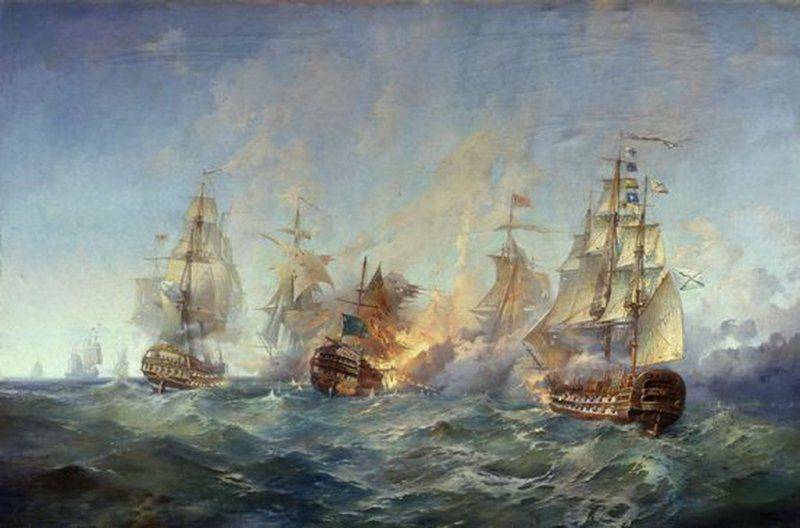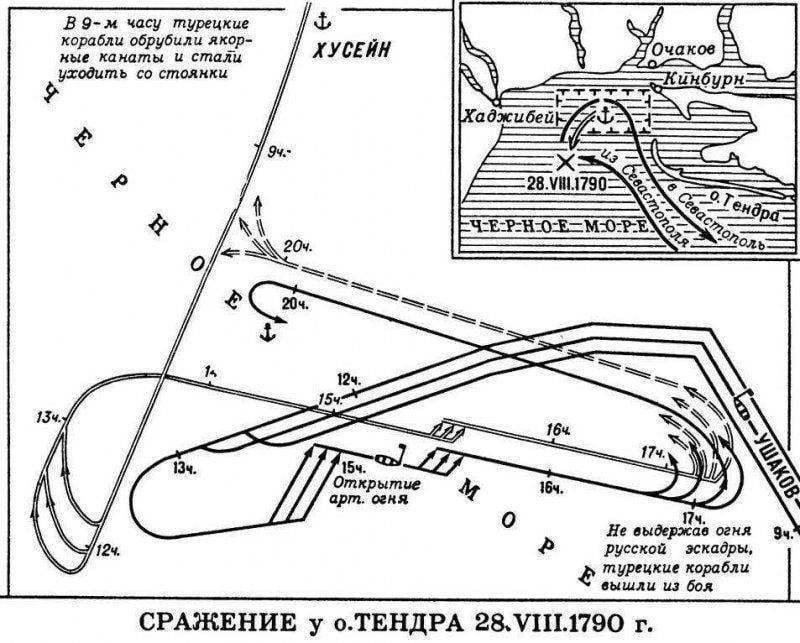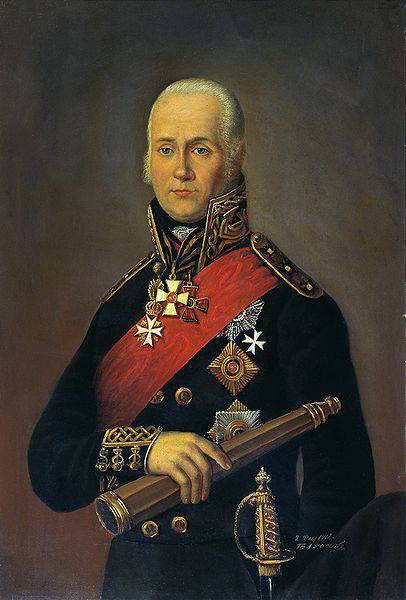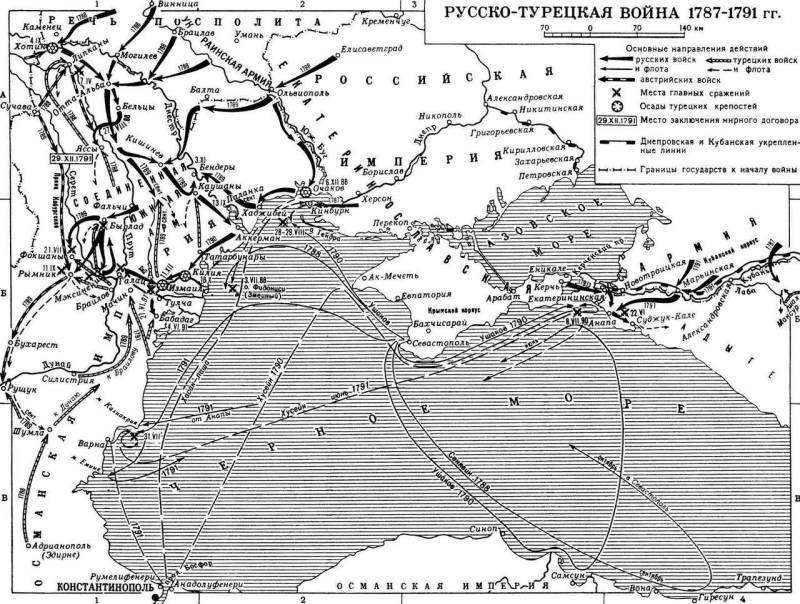The victory of the Russian squadron at Cape Tendra

September 11 marks the next Day of Russia's military glory - Victory Day of the Russian squadron under Rear Admiral Fedor Fedorovich Ushakov over the Ottoman fleet at Cape Tendra. This Day of Military Glory was established by Federal Law No. 32-FZ of March 13, 1995 on the Days of Military Glory and Memorable Dates of Russia.
The battle at Cape Tendra itself took place on August 28-29 (September 8-9), 1790, the battle at Cape Tendra took place. The dates of most battles that took place before the introduction of the Gregorian calendar in Russia in 1918 in this law were obtained by adding 13 days to the "old" date, that is, the difference between the new calendar and the old calendar dates that they currently have. However, the difference between the old and the new style of 13 days accumulated only by the 10th century. So, in the XVII century, the difference was 11 days, in the XVIII - XNUMX days. Therefore in historical science adopted other dates for these events than in this law.
prehistory
During the Russian-Turkish war 1768-1774. The Crimean Khanate became independent, and then the Crimean peninsula became part of Russia. The Russian Empire was actively developing the northern Black Sea coast - Novorossia, beginning the creation of the Black Sea Fleet and the corresponding coastal infrastructure. In 1783, the construction of the city and the port, which became the main base of the Russian fleet on the Black Sea, began on the shores of Akhtiar Bay. The new port was called Sevastopol. The basis for the creation of the new fleet were the ships of the Azov flotilla, built on the Don. Soon the fleet was replenished with ships built at the shipyards of Kherson, a new city founded near the mouth of the Dnieper. Kherson became the main shipbuilding center in the south of the empire. In 1784, the first battleship of the Black Sea Fleet was launched in Kherson. Also here the Black Sea Admiralty was established.
Petersburg tried to accelerate the formation of the Black Sea Fleet at the expense of part of the Baltic Fleet. However, Istanbul refused to let the Russian ships pass from the Mediterranean to the Black Sea. The port was eager for revenge, and sought to prevent the Russians from strengthening in the Black Sea region, and planning to return the lost territories. First of all, the Ottomans wanted to return the Crimea, and then the Northern Black Sea region. To reject Russia from the sea and restore the position that existed on the southern Russian borders for centuries. In this case, Turkey was supported by France and Britain, interested in the weakening of Russia.
The diplomatic struggle between the Ottoman Empire and Russia, which did not subside after the conclusion of the Kyuchuk-Kaynardzhy world, intensified with each passing year. The revanchist aspirations of Porte were actively fueled by Western European diplomacy. The British and French put strong pressure on Istanbul, called for "not to allow the Russian military fleet to the Black Sea." In August, 1787, the Russian ambassador in Constantinople, was presented with an ultimatum in which the Ottomans demanded the return of the Crimea and the revision of previously concluded agreements between Russia and Turkey. Petersburg has rejected these impudent demands. In early September, the Turkish authorities arrested the Russian ambassador Y. I. Bulgakov without an official declaration of war, and the Turkish fleet under the command of the Crocodile of Sea Battles, Gassan Pasha, left the Bosphorus in the direction of the Dnieper-Bug estuary. A new Russian-Turkish war has begun.
War
By the beginning of the war, the Russian fleet was significantly weaker than the Ottoman. Naval bases and the shipbuilding industry were in the process of being built. Lacked the necessary supplies and materials for the construction, armament, equipment and repair of ships. The Black Sea was still poorly understood. The vast territories of the Black Sea were at that time one of the distant outskirts of the empire, which was in the process of development. The Russian fleet was much inferior to Turkish in the number of ships: by the beginning of the hostilities, the Black Sea fleet had only 4 battleships, and the Turks - about 20. In terms of the number of corvettes, brigs, transports, the Turks had a superiority of about 3-4 times. Only on frigates Russian and Turkish fleets were approximately equal. The Russian battleships were inferior in qualitative terms: in speed, artillery weapons. In addition, the Russian fleet was divided into two parts. The core of the Black Sea Fleet, mainly large sailing ships, was based in Sevastopol, while rowing ships and a small part of the sailing fleet were located in the Dnieper-Bug estuary (Liman flotilla). The main task of the fleet was to protect the Black Sea coast in order to prevent the invasion of enemy troops.
Thus, if on land Turkey did not have an advantage over the Russian army, then at sea the Ottomans had an overwhelming superiority. In addition, the Russian fleet had a weak command. Admirals such as N. S. Mordvinov and M. I. Voinovich, although they had the full support of the court and many necessary connections for career development, were not warriors. These admirals were indecisive, inept and inactive, afraid of battle. They believed that it was impossible to enter into open battle with an adversary that had a visible superiority and adhered to linear tactics. That is, it was believed that if the enemy has more ships, people and guns, then defeat is inevitable.
It was fortunate for the Russian fleet that at this time Fedor Fedorovich Ushakov was decisive and possessing outstanding military and organizational skills among the senior officers of the fleet. Ushakov had no connections with the court, was not a well-born aristocrat and achieved everything with his talent and hard work, devoting his whole life to the fleet. It should be noted that Field Marshal Prince G. A. Potemkin, Commander-in-Chief of the land and naval forces in the south of the empire, saw Ushakov’s talent and supported him.
As a result, the Russian Black Sea Fleet, despite its weakness, was able to successfully withstand a strong enemy. In 1787-1788 The Liman flotilla successfully repulsed all enemy attacks, the Turkish command lost many ships. The Turks could not use their superiority in large sailing ships with powerful artillery armament, as the Liman had a situation that resembled the situation on the Baltic skerries during the Northern War, when the mobile rowing vessels of Tsar Peter successfully fought with the Swedish fleet.
While in the Dnieper-Bug estuary went fierce battles, the bulk of the Black Sea Fleet - Sevastopol squadron was inactive, being at its base. Rear Admiral Voinovich was afraid of a battle with the superior forces of the Ottomans. The cowardly admiral constantly found reasons not to take ships out to sea. Late with the withdrawal of the fleet at sea, he put the ships under a heavy storm (September 1787). The squadron was repaired for more than six months and was put out of action. Only in the spring of 1788, the combat capability was restored. However, Voinovich was again in no hurry to go to sea. Knowing the size of the powerful Ottoman fleet of Gassan Pasha, he was afraid of meeting the Turks and coming up with various pretexts to postpone the exit of the squadron into the sea. Only after the decisive demands of Potemkin, the Voinovich squadron set sail.
18 June 1788 The ships left Sevastopol. On the way, the squadron was delayed by headwinds and only after 10 days it reached Tendra Island. Towards moving the Ottoman fleet. Admiral Gassan Pasha had a tremendous superiority in strength: 2 had Turkish line ships 17 against Russian battleships (other ships had approximate equality: 10 Russian frigates and 20 auxiliary ships against 8 Turkish frigates, 3 bombardier ships and 21 bombers and 1500 bombers and 550 bombers and XNUMX bombers and XNUMX bombers and XNUMX bombers and XNUMX bombers and XNUMX bombers and XNUMX bombers and XNUMX bombers and XNUMX bombers. The Turks had a great advantage in artillery armament: more XNUMX guns against XNUMX Russian cannons. Voinovich was confused and could not lead the Russian ships into battle. At the moment of a decisive meeting with the enemy, he withdrew from the leadership of the Russian squadron, giving the initiative to the commander of the avant-garde, commander of the battleship Pavel to the captain of the brigadier rank F. F. Ushakov. For three days, the Russian and Turkish ships maneuvered, trying to take a more comfortable position for battle.
By July 3 (14) both fleets were opposite the mouth of the Danube, near the island of Fidonisi. On this day, the first naval battle of the Russian-Turkish war 1787-1791 took place. between the fleets of Russia and the Ottoman Empire (the battle of Fidonisi). The Ottomans were able to maintain the windward position, which gave a number of advantages to the ships. However, the Russian defeated the vastly superior enemy forces. It was the first baptism of the Sevastopol squadron - the main combat core of the Black Sea Fleet.
This battle had important consequences. Until now, the Ottoman fleet had domination of the Black Sea, not allowing Russian ships to make long hikes. Flights of Russian ships were limited to coastal areas. After this battle, when the Turks first retreated before the Russian squadron on the high seas, the situation changed. If before the battle at Fidonisi, many Turkish commanders considered Russian sailors inexperienced and unable to fight on the high seas, it now became clear that a new formidable force had appeared on the Black Sea.
In March, 1790, Fyodor Ushakov was appointed commander of the Black Sea Fleet. He had to spend a lot of work to improve the combat readiness of the fleet. Much attention was paid to the training of personnel and educational work. In any weather, Ushakov led ships into the sea and conducted sailing, artillery, boarding and other exercises. The Russian naval commander relied on the tactics of maneuverable combat and the training of his commanders and sailors. He gave a big role to the "useful occasion" when the opponent's indecision, his hesitations and mistakes, allowed the more proactive and strong-willed commander to win. This made it possible to compensate for the higher numbers of the Ottoman fleet and the better quality of the enemy ships.
The Ottoman fleet after the battle at Fidonisi for about two years did not undertake active operations in the Black Sea. The Turks built new ships and prepared for new battles. During this period there was a difficult situation in the Baltic. The British actively encouraged Sweden to oppose Russia. The Swedish elite considered that the situation was very beneficial for the start of the war with Russia, in order to restore a number of positions in the Baltic that Sweden had lost during the previous Russian-Turkish wars. At this time, Petersburg planned to open hostilities against Turkey in the Mediterranean, sending a squadron from the Baltic Sea. The Mediterranean squadron was already in Copenhagen, when it had to be urgently returned to Kronstadt. Russia had to wage war on two fronts - in the south and north-west. For two years there was a Russian-Swedish war (1788-1790). The Russian armed forces left the war with honor. The Swedes were forced to abandon their claims. But this conflict has greatly depleted the military-economic resources of the Russian Empire, which led to a delay in the war with Porto.
Tendra
The Turkish command planned to land in the 1790 year on the Caucasian coast of the Black Sea, in the Crimea and recapture the peninsula. Admiral Hussein Pasha commanded the enemy fleet. The threat was serious, as there were few Russian troops in the Crimea, the main forces were at the Danube Theater. The Turkish troops landed on ships in Sinop, Samsun and other ports could be transferred and landed in the Crimea in less than two days. Turkish troops had a bridgehead in the Caucasus, which could be used against the Crimea. The advanced stronghold of the Ottomans was the powerful fortress of Anapa. From here to Kerch to Feodosiya it took only a few hours of progress. In addition, the Ottomans could count on the "fifth column" - the uprising of the Crimean Tatars.
In Sevastopol, closely followed the situation. Ushakov was actively preparing the ships for the march. When most of the ships of the Sevastopol squadron were ready for long voyage, Ushakov went on a campaign with the aim of scouting the enemy forces and disrupting his communications in the southeastern part of the sea. The Russian squadron crossed the sea, went to Sinop, and from it passed along the Turkish coast to Samsun, then to Anapa, and returned to Sevastopol. Russian sailors captured more than a dozen enemy ships. Then Ushakov again brought his ships to the sea and 8 July (19 July) 1790 broke the Turkish squadron near the Kerch Strait. In battleships, both squadrons were equal, but the Ottomans had twice the size of other ships — bombarding ships, brigantine, corvettes, etc. As a result, the Turks had more 1100 guns against the 850 Russians. However, Admiral Hussein Pasha could not take advantage of the power. Turkish sailors fluttered under the Russian attack and took off running. The best performance of the Turkish ships allowed them to escape. This battle disrupted the landing of enemy troops in the Crimea.
After this battle, the fleet of Hussein Pasha disappeared at his bases, where the Turks carried out intensive work on the restoration of damaged ships. The Turkish naval commander concealed the fact of defeat from the Sultan, declared victory - the sinking of several Russian ships. To support Hussein, the sultan sent an experienced junior flagship - Seyid-bey. The Turkish command was still preparing the landing operation.
On the morning of August 21, the main part of the Ottoman fleet was concentrated between Haji Bey (Odessa) and Cape Tendra. Under the command of Hussein Pasha there was considerable power of the 45 ships: the 14 battleships, the 8 frigates and the 23 auxiliary ships, with the 1400 guns. The presence of the Turkish fleet restrained the activity of the Liman flotilla, which was supposed to support the offensive of the Russian ground forces.
25 August Fedor Ushakov brought the Sevastopol squadron into the sea, it included: 10 battleships, 6 frigates, 1 bomber ship and 16 auxiliary ships, with 836 guns. In the morning of August 28, the Russian fleet appeared at Tendra. The Russians found the enemy, and Admiral Ushakov gave the order to go for rapprochement. For the Ottomans was a complete surprise, they believed that the Russian fleet had not yet recovered after the battle of Kerch and was in Sevastopol. Seeing the Russian ships, the Turks rushed hurriedly to chop off the anchor, set sail and in disorder moved to the mouth of the Danube.
Russian ships chased the enemy. The Turkish avant-garde, led by the flagship Hussein Pasha, took advantage of the progress and took the lead. Fearing that the backward ships would be overtaken by Ushakov, pressed to the shore and destroyed, the Turkish admiral was forced to make a turn. While the Turks were rebuilding, the Russian ships, on a signal from Ushakov, lined up from three columns into a battle line; three frigates remained in reserve. At 3 in the afternoon, both fleets went parallel to each other. Ushakov began to reduce the distance, and gave the order to open fire on the enemy. The Russian naval commander used his favorite tactics - he became close with the enemy and concentrated fire on the enemy’s flagships. Ushakov wrote: "Our fleet drove the enemy under all the sails and beat it incessantly." The Turkish flagships were hardest hit, on which the fire of Russian ships was concentrated.
The chase lasted for several hours. In the evening, the Turkish fleet "at night darkness closed out of sight." Hussein Pasha hoped that he would manage to get away from the chase at night, as was the case during the Kerch battle. Therefore, the Turks went without lights and changed courses to bring down their pursuers. However, this time the Ottomans were unlucky.
At dawn the next day, the Turkish fleet was found on Russian ships, which was "scattered all in different places." The Turkish command, seeing that the Russian squadron is located nearby, gave a signal to join and depart. The Turks headed south-east. However, the damaged ships significantly slowed down and fell behind. Admiral 80-gun "Captain" closed the system. At 10, the Russian ship Andrei was the first to approach the main ship of the Turkish fleet and opened fire. Behind him came the ships "George" and "Transfiguration." The enemy ship was surrounded and subjected to brutal shelling. However, the Ottomans stubbornly resisted. Then the ship of Ushakov approached the "Captain". He stood at a distance of a pistol shot - 60 meters and "in the slightest time he struck him the most severe defeat." The ship burned and lost all the masts. The Turks did not withstand a powerful shelling and began to ask for mercy. The fire stopped. They managed to capture Admiral Seid Bey, captain of the ship Mehmet and 17 staff officers. A few minutes from the fire, the Turkish flagship flew into the air. Other ships of the Russian squadron overtook the Turkish 66-gun ship of the line "Meleki Bagari", surrounded it and forced to capitulate. Later it was repaired and commissioned under the name "John the Baptist." The rest of the Turkish ships were able to escape.

Results
The naval battle ended with the complete victory of the Russian fleet. In a two-day battle, the Ottomans were defeated, fled and completely demoralized, lost two battleships and several smaller ships. On the way to the Bosphorus, due to damage, another 74 gun ship of the line and several small ships sank. In total, more than 700 people were captured. According to Turkish reports, the fleet lost thousands of people killed and wounded to 5,5. The Turkish ships, as usual, were crowded with people, because of the regular desertions they recruited excess crews, plus landing forces. Russian losses were insignificant - 46 people were killed and wounded, which indicates the high military skills of the squadron of Ushakov.
The Black Sea Fleet won a decisive victory over the Ottomans and made a significant contribution to the overall victory. A significant part of the Black Sea was cleared of the Turkish fleet, which opened access to the sea for the ships of the Liman flotilla. With the assistance of the ships of the Liman flotilla, the Russian army took the fortresses of Kiliya, Tulcha, Isacchi, and then Ishmael. Ushakov inscribed one of its brilliant pages into the Russian marine chronicle. Ushakov’s maneuverable and decisive sea battle tactics fully justified themselves, the Turkish fleet ceased to dominate the Black Sea.
Congratulating Russian sailors on their victory at Tendra, Russian Commander-in-Chief Potemkin wrote: “The famous victory won by Black Sea forces led by Rear Admiral Ushakov on 29 on August last over the Turkish fleet ... serves to special honor and glory of the Black Sea Fleet. May this memorable incident fit into the journals of the Black Sea Admiralty Board to the everlasting recollection of the brave fleet of the Black Sea feats ... ” For his victory at Tendre, F. F. Ushakov was awarded the Order of Saint George of the 2 degree.

Fedor Fedorovich Ushakov

Information